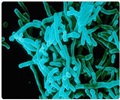Information about Clindamycin
Generic Name : ClindamycinUp-to-date prescription details regarding Clindamycin are provided here.
Pronunciation : klin da mye' sin
Learn the correct pronunciation of the Clindamycin, understand it's uses, recommended dosages, its indications, how to take, when to take, when not to take, side effects, special precautions, warnings and its and its storage instructions.You will also find a list of the medication's International and Indian brand or trade names, as well as its pricing information. For verification of the information presented on this page or for additional clarifications, it's advisable to consult your doctor.
ICD Code : Y41 Therapeutic Classification : Miscellaneous Anti- Infectives
Trade Names/Brand Names of Clindamycin
India :
acnesol (20 gm) |
Clincin (2 ml) |
Acnesol |
Clin -Gold |
Acneclin Gel |
Pim-Off |
Clenol-LB (100mg/100mg//1.5billion cells) |
Dalcinex (150mg/mL) |
Clinscar Capsule (300mg) |
Dalcinex (300mg)
International :
AntiRobe, Cleocin, ClindaRobe, Clinsol
Why is Clindamycin Prescribed? (Indications)
This medication is an antibiotic, prescribed for certain types of bacterial infections, including infections of the lungs, skin, blood, female reproductive organs and internal organs. It slows or stops the growth of bacteria.When should Clindamycin not be taken? (Contraindications)
Hypersensitivity.What is the dosage of Clindamycin?
Oral- The recommended dose range is 150 to 300mg two times per day. IV- The recommended dose range is 200 to 600 mg three times per day.Topical: Apply the cream over the affected area as directed by your physician.
How should Clindamycin be taken?
It comes as a capsule and liquid to take by mouth, with or without food. Granules should be taken with food.It also comes as a solution for injection to be administered by a healthcare provider into the vein. It also comes as skin preparations to apply topically.What are the warnings and precautions for Clindamycin?
• Caution should be exercised in patients with history of asthma, sensitive skin, diarrhea, kidney or liver disease, GI disease, any allergy, who are taking other medications, elderly, children, during pregnancy and breast feeding.• Take full course of treatment.
• Monitor liver function, kidney function and complete blood cell counts regularly while taking this medication.
What are the side effects of Clindamycin?
Gastrointestinal - Abdominal pain, inflammation of intestine/esophagus, nausea, vomiting and diarrhea.Hypersensitivity - Rash and hives.
Skin - Itching and vaginal inflammation.
Liver - Jaundice and abnormal liver function tests.
Genitourinary - BUN (blood urea nitrogen) , protein in urine and absence of urine.
Blood - Eosinophilia and decreased white blood cells.
Musculoskeletal - Joint inflammation.
What are the other precautions for Clindamycin?
Avoid excess dosage.What are the storage conditions for Clindamycin?
Store it at room temperature and away from excess heat and moisture.Schedule : H
Prescription drugs - Drugs to be sold only under the prescription of a Registered Medical Practitioner.






















